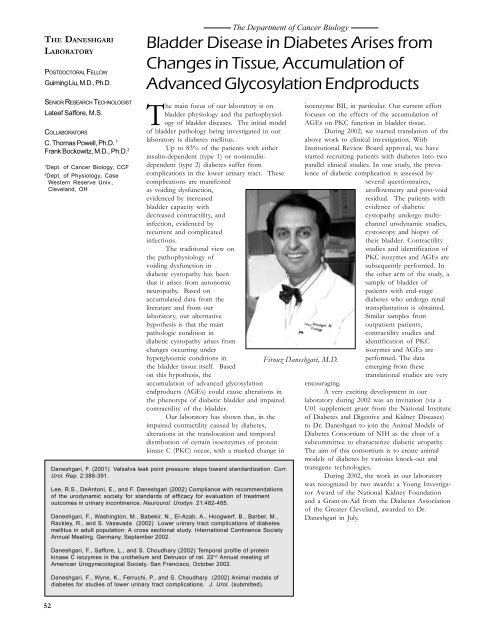Scientific Report 2003-2004 - Cleveland Clinic Lerner Research ...
Scientific Report 2003-2004 - Cleveland Clinic Lerner Research ...
Scientific Report 2003-2004 - Cleveland Clinic Lerner Research ...
- No tags were found...
You also want an ePaper? Increase the reach of your titles
YUMPU automatically turns print PDFs into web optimized ePapers that Google loves.
THE DANESHGARILABORATORYPOSTDOCTORAL FELLOWGuiming Liu, M.D., Ph.D.The Department of Cancer BiologyBladder Disease in Diabetes Arises fromChanges in Tissue, Accumulation ofAdvanced Glycosylation EndproductsSENIOR RESEARCH TECHNOLOGISTLateef Saffore, M.S.COLLABORATORSC. Thomas Powell, Ph.D. 1Frank Bockowitz, M.D., Ph.D. 21Dept. of Cancer Biology, CCF2Dept. of Physiology, CaseWestern Reserve Univ.,<strong>Cleveland</strong>, OHThe main focus of our laboratory is onbladder physiology and the pathophysiologyof bladder diseases. The initial modelof bladder pathology being investigated in ourlaboratory is diabetes mellitus.Up to 83% of the patients with eitherinsulin-dependent (type 1) or noninsulindependent(type 2) diabetes suffer fromcomplications in the lower urinary tract. Thesecomplications are manifestedas voiding dysfunction,evidenced by increasedbladder capacity withdecreased contractility, andinfection, evidenced byrecurrent and complicatedinfections.The traditional view onthe pathophysiology ofvoiding dysfunction indiabetic cystopathy has beenthat it arises from autonomicneuropathy. Based onaccumulated data from theliterature and from ourlaboratory, our alternativehypothesis is that the mainpathologic condition indiabetic cystopathy arises fromchanges occurring underhyperglycemic conditions inthe bladder tissue itself. Basedon this hypothesis, theaccumulation of advanced glycosylationendproducts (AGEs) could cause alterations inthe phenotype of diabetic bladder and impairedcontractility of the bladder.Our laboratory has shown that, in theimpaired contractility caused by diabetes,alterations in the translocation and temporaldistribution of certain isoenzymes of proteinkinase C (PKC) occur, with a marked change inDaneshgari, F. (2001) Valsalva leak point pressure: steps toward standardization. Curr.Urol. Rep. 2:388-391.Lee, R.S., DeAntoni, E., and F. Daneshgari (2002) Compliance with recommendationsof the urodynamic society for standards of efficacy for evaluation of treatmentoutcomes in urinary incontinence. Neurourol. Urodyn. 21:482-485.Daneshgari, F., Washington, M., Babekir, N., El-Azab, A., Hoogwerf, B., Barber, M.,Rackley, R., and S. Vasavada (2002) Lower urinary tract complications of diabetesmellitus in adult population: A cross sectional study. International Continence SocietyAnnual Meeting. Germany, September 2002.Daneshgari, F., Saffore, L., and S. Choudhary (2002) Temporal profile of proteinkinase C isozymes in the urothelium and Detrusor of rat. 22 nd Annual meeting ofAmerican Urogynecological Society. San Francisco, October 2002.Daneshgari, F., Wyne, K., Ferruchi, P., and S. Choudhary (2002) Animal models ofdiabetes for studies of lower urinary tract complications. J. Urol. (submitted).Firouz Daneshgari, M.D.isoenzyme BII, in particular. Our current effortfocuses on the effects of the accumulation ofAGEs on PKC function in bladder tissue.During 2002, we started translation of theabove work to clinical investigation. WithInstitutional Review Board approval, we havestarted recruiting patients with diabetes into twoparallel clinical studies. In one study, the prevalenceof diabetic complication is assessed byseveral questionnaires,uroflowmetry and post-voidresidual. The patients withevidence of diabeticcystopathy undergo multichannelurodynamic studies,cystoscopy and biopsy oftheir bladder. Contractilitystudies and identification ofPKC isozymes and AGEs aresubsequently performed. Inthe other arm of the study, asample of bladder ofpatients with end-stagediabetes who undergo renaltransplantation is obtained.Similar samples fromoutpatient patients,contractility studies andidentification of PKCisozymes and AGEs areperformed. The dataemerging from thesetranslational studies are veryencouraging.A very exciting development in ourlaboratory during 2002 was an invitation (via aU01 supplement grant from the National Instituteof Diabetes and Digestive and Kidney Diseases)to Dr. Daneshgari to join the Animal Models ofDiabetes Consortium of NIH as the chair of asubcommittee to characterize diabetic uropathy.The aim of this consortium is to create animalmodels of diabetes by varioius knock-out andtransgene technologies.During 2002, the work in our laboratorywas recognized by two awards: a Young InvestigatorAward of the National Kidney Foundationand a Grant-in-Aid from the Diabetes Associationof the Greater <strong>Cleveland</strong>, awarded to Dr.Daneshgari in July.52
















